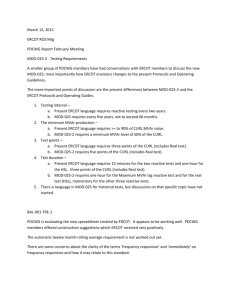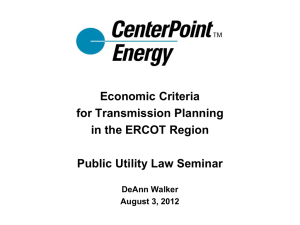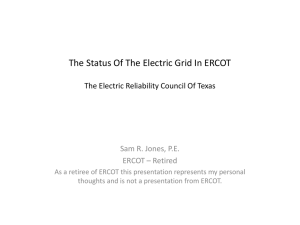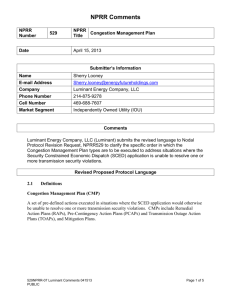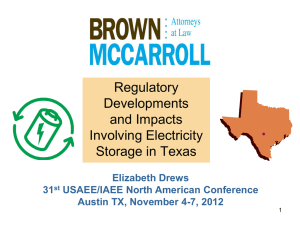529NPRR-13 ERCOT Comments 070913
advertisement
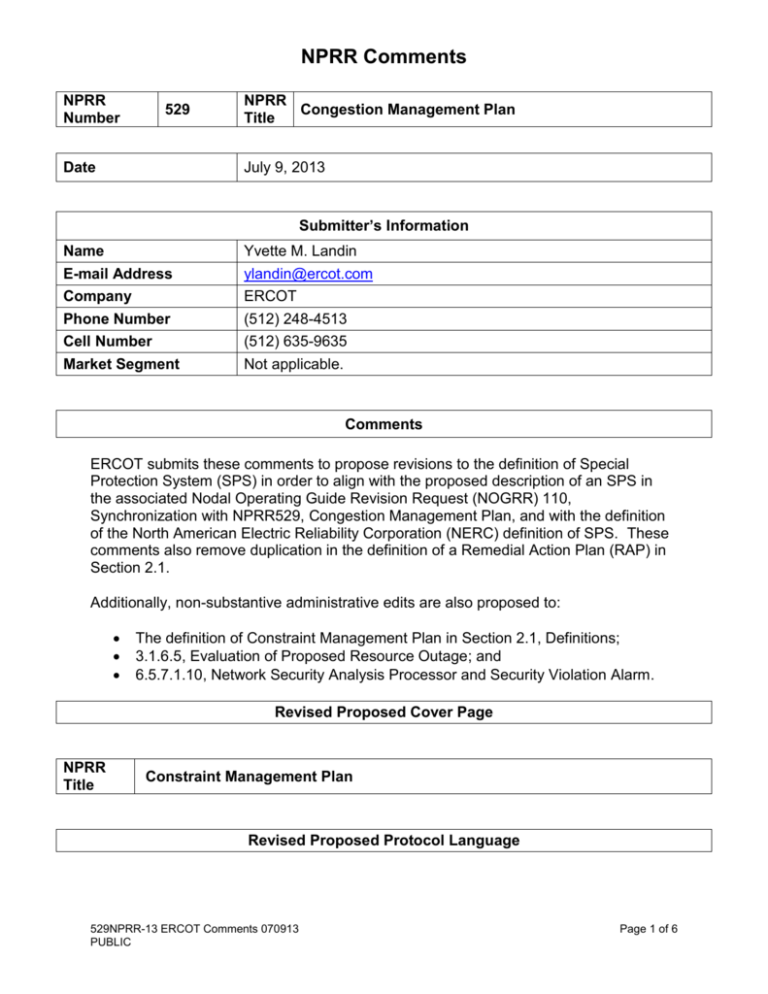
NPRR Comments NPRR Number 529 Date NPRR Congestion Management Plan Title July 9, 2013 Submitter’s Information Name E-mail Address Company Yvette M. Landin ylandin@ercot.com ERCOT Phone Number Cell Number (512) 248-4513 (512) 635-9635 Market Segment Not applicable. Comments ERCOT submits these comments to propose revisions to the definition of Special Protection System (SPS) in order to align with the proposed description of an SPS in the associated Nodal Operating Guide Revision Request (NOGRR) 110, Synchronization with NPRR529, Congestion Management Plan, and with the definition of the North American Electric Reliability Corporation (NERC) definition of SPS. These comments also remove duplication in the definition of a Remedial Action Plan (RAP) in Section 2.1. Additionally, non-substantive administrative edits are also proposed to: The definition of Constraint Management Plan in Section 2.1, Definitions; 3.1.6.5, Evaluation of Proposed Resource Outage; and 6.5.7.1.10, Network Security Analysis Processor and Security Violation Alarm. Revised Proposed Cover Page NPRR Title Constraint Management Plan Revised Proposed Protocol Language 529NPRR-13 ERCOT Comments 070913 PUBLIC Page 1 of 6 NPRR Comments 2.1 Definitions Constraint Management Plan (CMP) CMPs are a set of pre-defined actions executed in response to system conditions to prevent or to resolve one or more thermal or non-thermal transmission security violations. These plans may be developed in cases where studies indicate economic dispatch alone may be unable to resolve a transmission security violation or in response to Real-Time conditions where SCED is unable to resolve a transmission security violation. ERCOT will employ CMPs to facilitate the market use of the ERCOT Transmission Grid while maintaining system security and reliability in accordance with the Protocols and North American Electric Reliability Corporation (NERC) Reliability Standards. CMPs are intended to supplement, not to replace, the use of SCED for constraint management. CMPs include, but are not limited to the following: Mitigation Plan A set of pre-defined actions to execute post-contingency to address voltage issues or reduce overloading on one or more given, monitored Transmission Facilities to below their Emergency Rating with restoration of normal operating conditions within two hours. A Mitigation Plan must be implementable and may include transmission switching and Load shedding. Pre-Contingency Action Plan (PCAP) A set of pre-defined actions to execute pre-contingency to address voltage issues orreduce overloading on one or more given, monitored Transmission Facilities to below their Emergency Rating with restoration of normal operating conditions within two hours. A PCAP may include transmission switching and does not include Load shedding. Remedial Action Plan (RAP) A set of pre-defined actions to execute post-contingency to address voltage issues or in order to reduce loading on one or more given, monitored Transmission Facilities to below their Emergency Rating within 15 minutes without loss of reliability to the interconnected network. These plans may be relied upon in allowing additional use of the transmission system. RAPs may not include Load shedding. Temporary Outage Action Plan (TOAP) A temporary set of pre-defined actions to execute post-contingency, during a specified Transmission Facility or Resource Outage, in order to address voltage issues or reduce overloading on one or more given, monitored Transmission Facilities to below their Emergency Rating with restoration of normal operating conditions within two hours. A TOAP must be implementable and may include transmission switching and/or Load shedding. 529NPRR-13 ERCOT Comments 070913 PUBLIC Page 2 of 6 NPRR Comments Special Protection Systems (SPS) Special Protection Systems (SPSs) are automatic protective relay systems designed to detect abnormal or pre-determined ERCOT System conditions and take pre-planned corrective action, other than the isolation of faulted Transmission Facilities, to provide acceptable ERCOT System performance. SPS actions include, but are not limited to generation or transmission system configuration to maintain system stability, acceptable voltages, or acceptable Facility loadings. An SPS does not include under-frequency or Under-Voltage Load Shedding (UVLS), fault conditions that must be isolated, or out-of-step relaying (not designed as an integral part of an SPS). An SPS owner can be a Transmission Service Provider (TSP) or Resource Entity. 2.2 ACRONYMS AND ABBREVIATIONS CMP Constraint Management Plan PCAP TOAP Pre-Contingency Action Plan Temporary Outage Action Plan 3.1.6.5 (1) Evaluation of Proposed Resource Outage If a proposed Resource Outage, in conjunction with previously accepted Outages, would cause a violation of applicable reliability standards, ERCOT shall: (a) Communicate with the requesting Qualified Scheduling Entity as required under Section 3.1.6.8, Resource Outage Rejection Notice; (b) Investigate possible Constraint Management Plans (CMPs) to resolve security violations, based upon security and reliability analysis results and strive to maximize transmission usage consistent with reliable operation; and (c) Consider modifying the previous acceptance or approval of one or more Transmission Facilities or reliability Resource Outages, considering order of receipt and impact to the ERCOT System. (2) If transmission security can be maintained using an alternative considered in item (1)(b) and (1)(c), then ERCOT, may, in its judgment, direct the selected alternatives and approve the proposed Resource Outage. (3) If ERCOT does not resolve transmission security issues by using the alternatives considered in item (1)(b) and (1)(c), then ERCOT shall reject the proposed Resource Outage. 529NPRR-13 ERCOT Comments 070913 PUBLIC Page 3 of 6 NPRR Comments 3.10.7.4 Definition of Special Protection Systems and Remedial Action Plans (1) All Special Protection Systems (SPSs) and Remedial Action Plans (RAPs) used by ERCOT and the TSPs to maintain a secure system must be defined in the Network Operations Model. (2) Proposed new SPSs and RAPs and proposed changes to SPSs and RAPs must be submitted to ERCOT for review and approval by ERCOT and all directly affected TSPs and Resource Entities under the applicable procedures in the Operating Guides. Once a new or changed SPS or RAP is approved by ERCOT and all directly affected TSPs and Resource Entities, the TSP shall submit the approved SPS or RAP to ERCOT using an NOMCR. The NOMCR must include a detailed description of the system conditions required to implement the SPS or RAP. Execution of an SPS or RAP must be included or assumed in the calculation of LMPs as well as the Network Operations Model. ERCOT shall post all SPSs and RAPs under consideration on the MIS Secure Area within five Business Days of receipt by ERCOT. (3) ERCOT shall model, and include in the security analysis, approved SPSs and RAPs. ERCOT shall post on the MIS Secure Area all approved SPSs and RAPs at least two Business Days before implementation, identifying the date of implementation. 6.5.7.1.10 Network Security Analysis Processor and Security Violation Alarm (1) Using the input provided by the State Estimator, ERCOT shall use the NSA processor to perform analysis of all contingencies in the active list. For each contingency, ERCOT shall use the NSA processor to monitor the elements for limit violations. ERCOT shall use the NSA processor to verify Electrical Bus voltage limits to be within a percentage tolerance as outlined in the Operating Guides. (2) When the NSA processor notifies ERCOT of a security violation, ERCOT shall immediately initiate the process described in Section 6.5.7.1.11, Transmission Network and Power Balance Constraint Management. [NPRR393: Replace paragraph (2) above with the following upon system implementation:] (2) When the NSA processor notifies ERCOT of a security violation, ERCOT shall immediately: (a) Initiate the process described in Section 6.5.7.1.11, Transmission Network and Power Balance Constraint Management; (b) Seek to determine what unforeseen change in system condition has arisen that has resulted in the security violation, especially those that were 125% or greater of the Emergency Rating for a single SCED interval or greater than 100% of the Emergency Rating for a duration of 30 minutes or more; and (c) Where possible, seek to reverse the action (e.g. initiating a transmission clearance 529NPRR-13 ERCOT Comments 070913 PUBLIC Page 4 of 6 NPRR Comments that the system was not properly pre-dispatched for) that has led to a security violation until further preventative action(s) can be taken. (3) If SCED does not resolve a transmission security violation, ERCOT shall attempt to relieve the security violation by: (a) Confirming that pre-determined RAPs are properly modeled in the system; (b) Instructing Resources to follow Base Points from SCED if those Resources are not already doing so; (c) Instructing Resources update the Resources Status in the Current Operating Plan (COP) from ONTEST to ON in order provide more capacity to SCED; (d) Instructing Resources to redistribute Ancillary Services to provide capacity to SCED; (e) Deploying Resource-Specific Non-Spinning Reserve Service; (f) Committing additional Generation Resources through the Reliability Unit Commitment process; (g) Removing conflicting non-cascading constraints from the SCED process; (h) Re-Dispatching generation by over-riding High Dispatch Limits (HDLs) and Low Dispatch Limits (LDLs); and (i) Instructing TSPs to utilize Reactive Power devices to manage voltage; and (j) If all other mechanisms have failed, ERCOT may authorize the expedited use of a Temporary Outage Action Plan (TOAP) or Mitigation Plan. (4) NSA must be capable of analyzing contingencies, including the effects of SPSs and RAPs. The NSA must fully integrate the evaluation and deployment of SPSs and RAPs and notify the ERCOT Operator of the application of these SPSs and RAPs to the solution. (5) The Real-Time NSA may employ the use of appropriate ranking and other screening techniques to further reduce computation time by executing one or two iterations of the contingency study to gauge its impact and discard further study if the estimated result is inconsequential. [NPRR393: Insert paragraph (6) below upon system implementation:] (5) ERCOT shall report monthly: (a) All security violations that were 125% or greater of the Emergency Rating for a 529NPRR-13 ERCOT Comments 070913 PUBLIC Page 5 of 6 NPRR Comments single SCED interval or greater than 100% of the Emergency Rating for a duration of 30 minutes or more during the prior reporting month and the number of occurrences and congestion cost associated with each of the constraints causing the security violations on a rolling 12 month basis. (b) Operating conditions on the ERCOT System that contributed to each transmission security violation reported in paragraph (6)(a) above. Analysis should be made to understand the root cause and what steps could be taken to avoid a recurrence in the future. 529NPRR-13 ERCOT Comments 070913 PUBLIC Page 6 of 6


